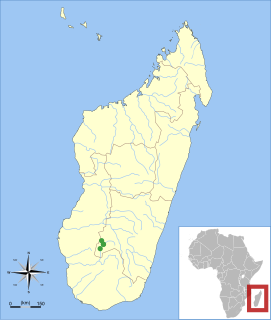
Orycteropodidae is a family of afrotherian mammals. Although there are many fossil species, the only species surviving today is the aardvark, Orycteropus afer also known as "Qarandi" or "seddex-suulay" in the Somali language. Orycteropodidae is recognized as the only family within the order Tubulidentata, so the two are effectively synonyms.

Gerbillinae is one of the subfamilies of the rodent family Muridae, it includes the gerbils, jirds and sand rats. Once known as desert rats, the subfamily includes about 110 species of African, Indian, and Asian rodents, including sand rats and jirds, all of which are adapted to arid habitats. Most are primarily active during the day, making them diurnal, and almost all are omnivorous.

Waters's gerbil is distributed mainly in Sudan, Somalia, and Djibouti.
The cushioned gerbil is distributed mainly in Somalia, Ethiopia, Djibouti and Kenya.
Dunn's gerbil is a rodent species distributed mainly in Eritrea, Ethiopia, Somaliland and Djibouti. It is an animal of dry grassland and rocky plains. It is also sometimes called the "Somalia gerbil", not to be confused with the Somalian gerbil or the Somali gerbil.

Neumann's grass rat is a species of rodent in the family Muridae. It is found in Ethiopia, Somalia, Sudan, Tanzania, and possibly Kenya. Its natural habitats are dry savanna and subtropical or tropical dry shrubland.
Dipodillus is a genus of rodent in the family Muridae. It is sometimes classified as a subgenus of the genus Gerbillus. It contains the following species:
The black-tailed gerbil is a species of rodent found in Ethiopia, Kenya, Somalia, and Tanzania. Its natural habitats are dry savanna, subtropical or tropical dry shrubland, and arable land.
Phillips's gerbil is a species of rodent found in Ethiopia, Kenya, and Somalia. Its natural habitat is subtropical or tropical dry shrubland.
The fringe-tailed gerbil is a species of rodent found in Central African Republic, Chad, Eritrea, Ethiopia, Kenya, Niger, Somalia, Sudan, Tanzania, Uganda, possibly Cameroon, and possibly Nigeria. Its natural habitats are dry savanna, moist savanna, subtropical or tropical dry lowland grassland, arable land and urban areas.
Phrynomantis somalicus, also known as Somali rubber frog or Somali snake-necked frog, is a species of frog in the family Microhylidae. It is known from southern Ethiopia and southern Somalia. Its total distribution is poorly known and might extend into Kenya.

The Somali fiscal is a species of bird in the family Laniidae. Other common names include the Karoli fiscal, the Somali fiscal shrike and the Somali shrike. The bird is found in Djibouti, Ethiopia and Somalia in the Horn of Africa, as well as in Kenya in the African Great Lakes region. Its natural habitat is subtropical or tropical dry shrubland.
Oxyophthalmellus somalicus is a species of praying mantis found in Ethiopia, Kenya, Somalia, and Tanzania.

The Ethiopian xeric grasslands and shrublands ecoregion is a semi-desert strip on or near the Red Sea and the Gulf of Aden coasts in Eritrea, Ethiopia, Djibouti and Somaliland. This ecoregion lies mainly between sea level and 800 meters (m) elevation. There are, however, many hills and massifs, which range up to 1300 m as well as outstanding fault-induced depressions, such as the Danakil, lying as low as 155 m below sea level. This region is extremely active tectonically, experiencing many earthquakes and intermittently active volcanoes. Rainfall is very low and yearly averages range from 100 to 200 millimeters (mm), with less rain falling closer to the coast. There are many species of interest, including the endemic Archer's lark, a species of dragon tree, and a large suite of desert ungulates, including the last viable population of African wild ass.

The Isalo serotine is a vespertilionid bat of Madagascar in the genus Neoromicia. It is known only from the vicinity of the Isalo National Park in the southwestern part of the island, where it has been caught in riverine habitats. After the first specimen was caught in 1967, it was described as a subspecies of Eptesicus somalicus in 1995. After four more specimens were collected in 2002 and 2003, it was recognized as a separate species. Because of its small distribution and the threat of habitat destruction, it is considered "vulnerable" in the IUCN Red List.
Eryx somalicus, known commonly as the Somali sand boa, is a species of small snake in the Boidae family. As its scientific name and common name suggest, it is found in Somalia, but may also be present in eastern Ethiopia.
The Somali dwarf gecko is a species of gecko found in northern Kenya, Somalia and Ethiopia.
Platyceps somalicus is a species of snake of the family Colubridae. It is found in Somalia and Ethiopia. It also known as the Ogaden racer, Ogaden whip snake, and Audo racer.
Pristurus somalicus, also known as the Somali rock gecko or Somali semaphore gecko, is a species of lizard in the Sphaerodactylidae family found in Somalia and Ethiopia.
The Somali writhing skink is a species of skink found in Somalia, Ethiopia, Kenya, and Tanzania.







